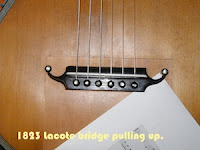 |
| My working drawing of Lacote 1823 |
Back then, I had gotten as far as assembling the the side ribs, the front and rear blocks, the linings for the ribs and gluing on the back. When I started to work on the guitar again a few months ago I prepared the harmonic bars for the soundboard. In the 9/10/2011 post I described heat bending the bars for the back and the reason for doing so. I followed the same procedure for the soundboard bars but only the two for the lower bout were bent. The two above the rosette are flat. These were then glued securely into slots the lining.
I like to use Italian spruce for the the soundboards of my 19th century guitars. It is light weight but resilient so I can use a thicker top (3mm) that gives a woodier tone without sacrificing speed of response or decay. You'll notice that I use a maple bridge plate. The material is left over from the rib stock and, like the rib thickness, is 1.2mm thick. I taper it from the peak along the horizontal axis to nothing at the edges. Few original early guitars were fitted with bridge plates it seems, but they were often added in the guitars' later life. I find that adding them increases the guitar's power. They also protect the underside of the soundboard from the eroding effect of the balled-up ends of the strings -- old guitars are really crewed up under the bridge.
I like the idea of stretching the soundboard over the assembled bars and side ribs and gluing it in place in as a single procedure. The usual method gluing bars to the belly and then fitting the bar ends to the side ribs involves a lot of trial and error that can lead to compromises and distortions. I think that the equilibrium that is achieved with the stretch method is beneficial for tone production.
Clamping is initially done with painter's tape, then foam lined curved or flat cauls and an assortment of other clamps are added. I use a slow setting fish glue that allows time for assembly.

sawn maple and laid out the contours. The peghead is fitted with a long v-joint and the heel is a separate block that sits on a sloped surface that increases the length of the gluing surface. In the photo I have already made the initial cuts for the peghead joint. Fitting this joint is difficult and time-consuming so it is important to make these cuts accurately.
Guitars often are the victims of carelessness and as a consequence pegheads are broken. If the damage is serious enough the peghead is discarded and a new one grafted on. That undoubtedly was the fate of my model (right). I thought this was an interesting incident in the guitar's history and I decided to model it.
Next time I'll describe making and installing the banding, assembling the rosette, fretting and embedding the metal belly frets, making the bridge and varnishing.













